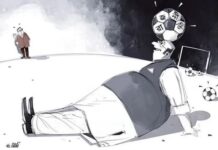Sadeq Khan
These two factors, to judge by media reactions, created a sense of normalcy in the body politic after five months of almost continual disturbances and disastrous events. Indeed, at least in the capital city, last week was one of the quietest of 2013, provided that continuation of simmering labour unrest, stray murders and discovery of dead bodies, police raids to pick-up mainly Jamat-Shibir activists, intra- and inter-party factional fights, armed violence in the turfs of political rivalry or protection racketeering, and incidents of violent street crimes are not taken into account. That proviso represents routine aspects of insecurity of life in the capital these days.
These two factors, to judge by media reactions, created a sense of normalcy in the body politic after five months of almost continual disturbances and disastrous events. Indeed, at least in the capital city, last week was one of the quietest of 2013, provided that continuation of simmering labour unrest, stray murders and discovery of dead bodies, police raids to pick-up mainly Jamat-Shibir activists, intra- and inter-party factional fights, armed violence in the turfs of political rivalry or protection racketeering, and incidents of violent street crimes are not taken into account. That proviso represents routine aspects of insecurity of life in the capital these days.
While life in mofussil districts were less insecure from random violence by criminal or political racketeers, public unrest with half day or dawn-to-dusk hartals observed in various zilla or upozilla headquarters for one cause or another continued to shake the administration and arrested normal socio-economic activity, exceptions being made by the agitators for the city corporations under Mayoral elections. The administration, particularly the police in most mofussil districts, continued to act coercively, and make indiscriminate arrests for blackmail booty or for preventive detention. In some places there were triangular clashes between the agitators, the police and pro-government activists, the last-named increasingly feeling the heat of public antipathy. The situation countrywide remained patently abnormal.
A particular worry for the ruling coalition, acutely felt by its Mayoral candidates in the four city corporations scheduled mid-June, is the antipathy of voters sympathising with Hefazat-e-Islam activists. Non-political organisation as it is, the 3-year old Hefazat-e-Islam conglomerate has earned the distinction of a moral guide for the common man in the contentions socio-political imbroglio obtaining in Bangladesh.
Its leaders notified and organised massive mobilisations with a month’s break each time to press for fulfilment of a 13-point charter, most of which have been and could remain pending for a long time, but the boiling ones were those of government action and new law against maligners of the Prophet of Islam who have been indulging in “aggressive secularism” in the name of the spirit of 1971 liberation war under government protection. The government’s coercive measures had obtained significant success in muting major political opposition as well as media outcry. So the Home Ministry thought it could crush the non-political and naive Hefazat agitation by one sweep of heavy-handed coercive action. This they did in the dark of the night between May 5 and May 6, when according to Hefazat leaders their following who assembled for Dhaka siege at six entrances to the capital were “lured into a trap” to a police-permitted spot of assembly in Motijheel commercial district of Dhaka while their leader was prevented from coming there as they waited for his audience.
The sit-in that followed was cleared by brutal police action at dead of night, switching off the lights in the area and spraying bullets, rubber-bullets, teargas shells and baton charges on sleeping or sleepy unarmed men. It was called a massacre by the Hefazat and the political Opposition. The government’s immediate aim of winning the battle to crush Hefazat’s capacity for mobilisation was achieved, but it may have lost the war to win the people’s minds altogether.
Force of 10,000 personnel
As the world media and international human rights bodies are still mulling over the messages from Bangladesh human rights outfit Odhikar, amongst others, that some hundreds of people (over 3000 according to some reports) died during a “killing spree” by a force of 10,000 made up of police, paramilitaries and armed men from the ruling Awami League, bodies were strewn about the streets of Dhaka’s commercial district before they were whisked away in dump trucks, and deadly clashes followed in the morning elsewhere, such as at Narayanganj, south of the capital, where 20 more people were killed in broad daylight, now posters have begun appearing all over the country in Bangladesh with gruesome internet pictures of massacre in Motijheel, and asking people to call the ruling coalition to account. In cities and towns the posters have been taken off from the wall by the police, but how can the police strip the impression they left in the minds of suburban or rural people or of internet social media users anywhere?
By the end of the working week, the parliamentary opposition has also struck back, boycotting the presentation of the budget by the Finance Minister. The budget, tabled with a huge allocation to revive the Padma Bridge project after World Bank denunciation and withdrawal of loan for “corruption conspiracy” by government bigwigs protected by the top ruling party leadership, has been called a sham by civil society experts and opposition politicians alike. Public grievances and police tyranny aside, any residual trust in the ruling coterie’s words or deeds have all but evaporated. With the parliamentary opposition coming out of the budget session and the rounds of agitational programmes gripping mofussil districts, many wonder whether the country is back to square 1 of political impasse.









